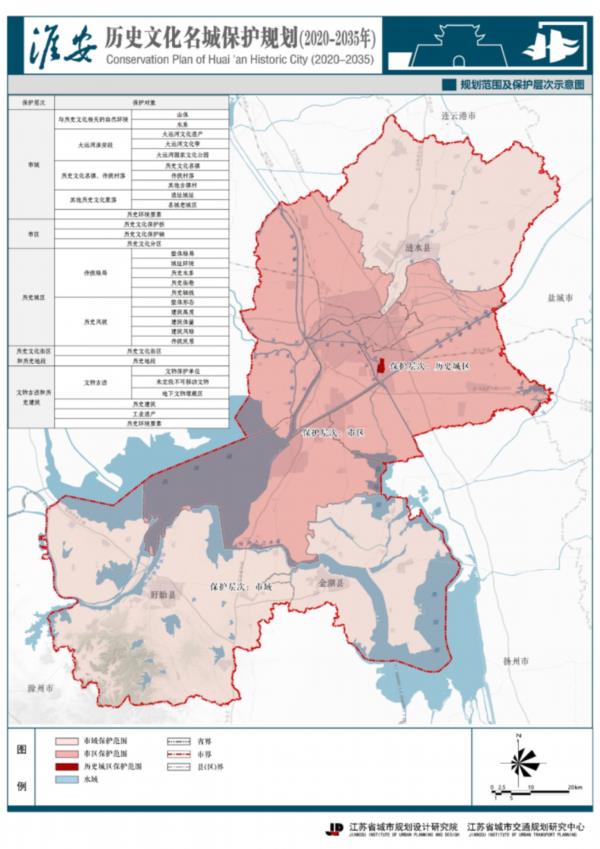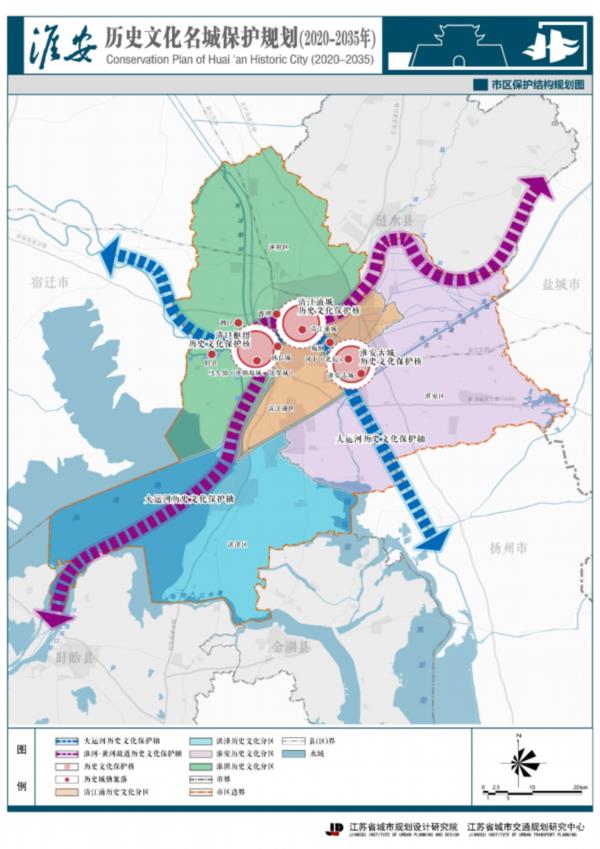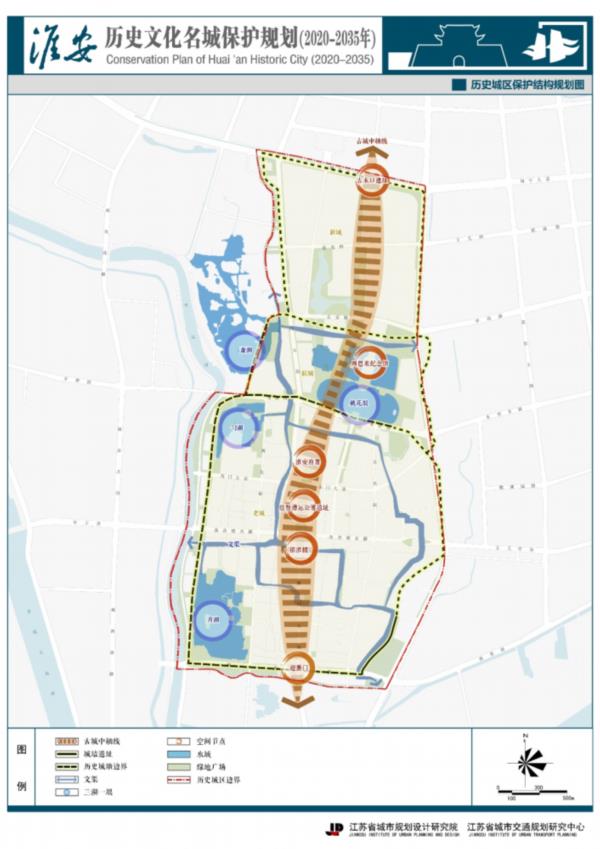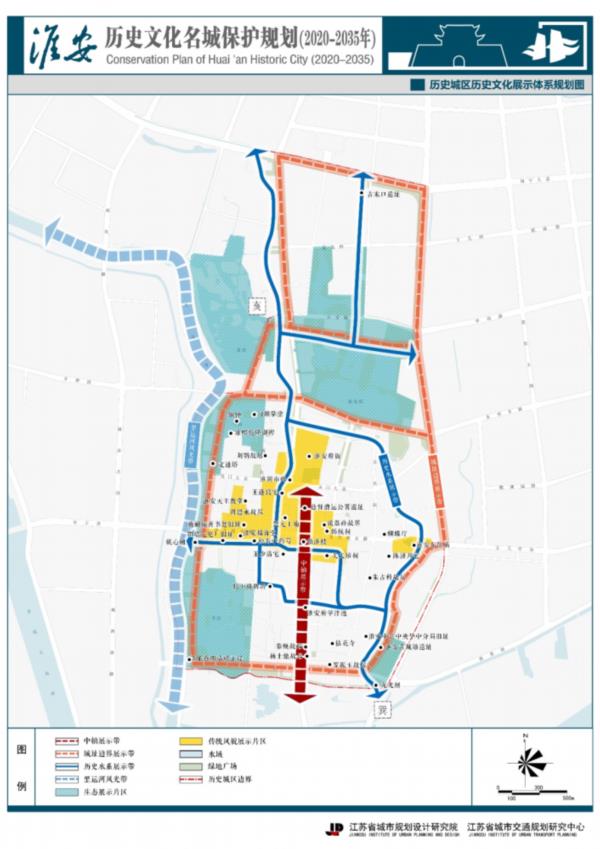Heavy! The publicity of the protection plan of Huai ‘an historical and cultural city highlights the characteristics and value of the famous city of "Canal Capital"
"The following is the original content"
Chapter I General Provisions
1. Planning guiding ideology
We will fully implement the spirit of the 19th National Congress of the Communist Party of China, the Central Urbanization Work Conference and the Central Urban Work Conference, always adhere to the people-centered principle, actively respond to the construction of the Grand Canal Cultural Belt and the Grand Canal National Cultural Park, effectively protect Huai ‘an historical and cultural city and various cultural heritages, continuously improve the urban and rural living environment, meet the material and spiritual needs of modern social clubs, enhance the cultural characteristics and vitality of cities, enhance the people’s sense of acquisition, and promote the comprehensive, coordinated and sustainable development of urban economy and society.
2. Protect the target
● 1. Concise the value connotation of historical and cultural cities.
● 2. Improve the protection system of historical and cultural cities.
● 3. Combination of overall protection and key protection.
● 4. Systematically improve the living environment of historic city.
5. Make protection and repair plans according to local conditions.
3. Planning scope
The planning scope is Huai ‘an city, including Huai ‘an District, Qingjiangpu District, Huaiyin District, Hongze District, Lianshui County, Xuyi County and Jinhu County.

4. Planning period
The planning period is 2020-2035, with the short term to 2025 and the long term to 2035.
Chapter II Value of Famous Cities
5. Value of famous cities
It has witnessed the historical process of human reproduction, geographical changes and settlement changes in the lower reaches of Huaihe River, and is an important carrier that retains multiple historical information.
As the center connecting the north and south rivers and waterways, it played an important role in maintaining the economic lifeline of the feudal empire and witnessed the unique cultural tradition of waterway transportation in ancient China.
The port transport project, represented by Qingkou Hub, has solved the problem that the Grand Canal of China will cross the Yellow River, reflecting the superb technology of water conservancy project survey, design, construction and maintenance in ancient China.
The unique pattern of connecting the three cities, reflecting the beauty of the sea and the sea, embodies the wisdom of ancient scholars in running the city by taking the law naturally and adapting to local conditions.
Huai ‘an is the hometown of Premier Zhou Enlai, an important carrier to carry forward the spirit of Zhou Enlai, and it has nurtured a brave cultural tradition and a dignified and heroic revolutionary spirit.
It shows the historical urban landscape and traditional street pattern formed in the process of continuous evolution, and embodies the architectural art and aesthetic interest with both North and South characteristics.
Chapter III Protection System
6. Protection system
Adhere to the concept of overall protection, and establish a protection system of five levels, namely, city area, urban area, historical city area, historical and cultural blocks and lots, cultural relics and historic buildings, and two parts, namely, material cultural heritage and intangible cultural heritage.
The scope of city-level protection is Huai ‘an City, including Huai ‘an District, Qingjiangpu District, Huaiyin District, Hongze District, Lianshui County, Xuyi County and Jinhu County.
The urban level protection scope is Huai ‘an urban area, including Huai ‘an District, Qingjiangpu District, Huaiyin District and Hongze District.
The level protection scope of the historical urban area is Chuzhou Avenue in the east, Jianhe River in the south, Wenqu, the southeast shore of Xiaohu and the Li Canal in the west, and Xiangyu Avenue in the north, with a total area of about 5.6 square kilometers. The scope of the environmental coordination area of the historic city is the expansion of the historic city to Chengxi North Road and Li Canal in the west, with a total area of about 1.5 square kilometers.

Chapter IV Protection and Utilization of Municipal History and Culture
Section 1 Natural environment related to history and culture
7. Mountain
Protect the mountains in the Dabie Mountains in the southwest of Xuyi, protect the mountains such as QingNiu Shan, Xiangshan, Qidashan, First Mountain, Tiantai Mountain, Duliang Mountain, Mopan Mountain, Miaoshan Mountain and Laojun Mountain in Xuyi, and protect the mountains such as Dayun Mountain in the east of Xuyi.
8. Water system
Protection of the Grand Canal, Huaihe River, Huaihe River into the river channel, Huaihe River into the sea channel, the main irrigation canal in northern Jiangsu, the old Yellow River, Huai Shu Xin He Er He, Yan He and other river systems. Promote the ecological management of rivers, strengthen the pollution prevention and control of river sections flowing through rural areas, form the structure of natural water ecosystem, and enhance the ecological corridor function of rivers. Protect the water bodies of Hongze Lake, Baima Lake, gaoyou lake, baoying lake and Lixiahe Lake. Protect the original ecological natural coastline, moderately develop the recreational function coastline, and strengthen the construction of shelterbelt along the lake.
Section 2 Huai ‘an Section of the Grand Canal
9. World Cultural Heritage of the Grand Canal
Protect the world cultural heritage of the Grand Canal, such as the Qingkou hub area and the ruins area of the Governor’s Office of Grain Transportation.
10. Cultural Heritage of the Grand Canal
Protect the Grand Canal rivers, hydraulic relics, all kinds of associated historical relics, historical blocks, villages and towns and related environmental landscapes other than the World Cultural Heritage of the Grand Canal.
Chapter V Protection and Utilization of Urban History and Culture
11, protect the target
● 1. Holistic protection of historical and cultural settlements
● 2. Regional protection highlights the historical city.
● 3. Connecting all kinds of heritages in series with historical rivers.
● 4. Differentiate and set the partition guidance strategy.
12. Spatial structure
Protect the historical and cultural heritage and its dependent natural environment in the urban area as a whole, show the historical context accumulated in different historical periods, highlight the characteristics and values of famous cities, and form "three cores and two axes; Four-zone and multi-point protection space structure. The "three cores" are the historical and cultural protection cores of Huai ‘an Ancient City, Qingjiang Pucheng and Qingkou Hub; The "two axes" are the historical and cultural protection axes of the Grand Canal and the old Huaihe-Yellow River; "Four Districts" are the historical and cultural divisions of Huai ‘an District, Qingjiangpu District, Huaiyin District and Hongze District; "Multi-point" refers to the settlement of many historical towns along the Grand Canal and the old Huaihe-Yellow River Road.

Chapter VI Protection and Utilization of Historic Cities
13, protect the target
● Pattern protection: protect the overall pattern of "three cities are connected, the central axis is symmetrical, and the sea is beautiful".
● Style protection: protect the traditional style and features of North-South integration, combination of rigidity and flexibility, and blue bricks and gray tiles.
● Road traffic: form a slow-moving, green and intensive ancient city traffic system.
● Living environment: build a high-quality living environment with people-oriented and convenient service.
● Municipal engineering: to build a modern infrastructure that meets the protection requirements and has perfect functions and intensive wisdom.
● Safety and toughness: build a safe and reliable disaster prevention and environmental protection system with perfect management.
14. Spatial structure
Form an overall structure of "three cities, one axis, three lakes and one canal". "Three cities" is the overall structure of the triple city formed by Huai ‘an old city, joint city and new city; "One axis" is the north-south central axis of "Nanmen Street-Zhenhuai House-the site of Governor’s Water Transportation Office-Huai ‘an Government Office-Taohuayun-Gumukou Site" which runs through Sanlian City. "Three Lakes" are Moon Lake, Shao Lake and Xiao Lake, and "One Canal" is Wenqu.

15. Overall pattern
Protect the overall spatial pattern of "three cities are connected, the sea is beautiful, and the axis is symmetrical" composed of "city, river, lake and street" and important historical spatial node elements.
16, display system
1. Greenway around the city
Combined with the ruins of the city wall, a greenway around the city with a total length of about 12 kilometers was built with Xiangyu Avenue, Chuzhou Avenue, Beimen Street, Yonghuai Road and Nanxun Road as carriers. Connect the city wall ruins park, Qingcheng Gate ruins park, Lanyunmen city wall ruins, Gumukou Park, Shaohu Lake and Yuehu Lake in series to show the unique pattern of "three cities connected" in the historical city.
2. Water Green Network
The Wenqu River is connected in series with water systems such as "Three Lakes and One Yin" and Jianhe River, and the waterfront green space is set up to form a water green network covering the historical city. It is connected with important historical and cultural resources such as Zhou Enlai’s former residence, Wentong Tower, bronze bell, Zhenhuai House, Guan Tianpei Temple and Dongyue Temple, and a number of viewing nodes are built to show the historical pattern of "three wonders embracing each other, and the harmony between the sea and the sea" in the historical city, as well as the ancient literati taking the method.
3. Historical streets and lanes
Systematically rectify historical streets and lanes, improve the pedestrian space environment, form a complete pedestrian space network, and connect the greenway around the city with the historical water system. Add a sign system to enhance the vitality of streets and lanes, and show the historical urban landscape and traditional street and lane pattern formed in the historical process of continuous evolution.
4. Historical axis
Renovation of "Huai ‘an Government Office — Ruins of the Governor’s Office of Grain Transportation — Zhenhuai House — Nanmen Street — The interface between the two sides of the central axis of the old city of Yingxunmen highlights the urban pattern of "central axis symmetry" in the historical city and shows the historical urban landscape and traditional street pattern formed in the historical process of continuous evolution.
5. Business card space
Focus on shaping the business card space of Gumukou, Zhou Enlai Memorial Hall, Wentong Tower, Caoyun Square, Zhenhuai House, Huai ‘an Government Office, City Wall Ruins Park, Longguangge and Liyun, select the overlooking nodes in the open public space, optimize the visual field landscape, and show the architectural art and aesthetic interest of the historical city with the north-south characteristics formed in the historical process of continuous evolution.

Chapter VII Protection and Utilization of Historical and Cultural Blocks
17. Historical and Cultural Blocks of Hexia Ancient Town
Protect the traditional street pattern and spatial form of historical and cultural blocks in Hexia ancient town. Protect the history of Hexia ancient townCultural protection units and historical buildings at all levels in the cultural block. Protect the historical features of the historical and cultural blocks of Hexia ancient town and the historical and environmental elements such as rivers, revetments, houses, gardens, brick carvings and ancient trees.
18. Xuma Lane — Longwo Lane — Shangbanjie historical and cultural block
Protect Xu Ma Lane — Longwo Lane — The overall spatial pattern and morphological characteristics of Shangban Street historical and cultural block. Protect cultural protection units and historical buildings at all levels such as Zhou Enlai’s former residence in the block. Protect historical environmental elements such as historical streets, docks, revetments, ancient bridges, ancient and famous trees, and cultural canals in the block. Protect intangible cultural relics with red culture as the core.
Chapter VIII Protection and Utilization of Cultural Relics and Historic Buildings
19, cultural relics protection units
According to "People’s Republic of China (PRC) Cultural Relics Protection Law" and "People’s Republic of China (PRC) Cultural Relics Protection Regulations".In-situ protection, delimit the protection scope and construction control zone of cultural relics protection units. It is not allowed to change the original condition, appearance and environment of cultural relics. If necessary repairs are needed, the principle of "not changing the original state" should be followed under the guidance of experts, so as to "repair the old as before" and strictly follow legal procedures.
20, underground cultural relics buried area
Protect related sites, improve the protection management system, strengthen the construction of infrastructure and site protection and exhibition facilities, and improve the level of protection, exhibition and utilization.
21. Historical buildings
improveThe protection and utilization standards of historical buildings are standardized, and the protection management and rational utilization measures of historical buildings with Huai’ an local characteristics are put forward.
Chapter IX Protection and Utilization of Intangible Cultural Heritage
22, protect the object
Protect 203 intangible cultural heritages in the city, including 7 at the national level, 33 at the provincial level and 163 at the municipal level.
23. Overall protection
1 focus on the protection of projects listed in the national, provincial, municipal and county-level intangible cultural heritage representative projects, in accordance with the requirements of special protection planning at all levels.
2. Improve the excavation, recording, sorting and registration of intangible cultural heritage, and establish archives and databases for projects listed in the national, provincial and municipal intangible cultural heritage lists. Classified protection shall be implemented according to the methods of rescue protection, memory protection, productive protection and regional overall protection.